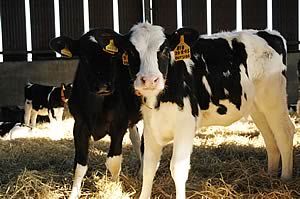| 29/08/08
Preparing cows for calving, and managing calves within the first few days of life are crucial if dairy farmers are to protect their animals’ future health and subsequent performance, according to Maggie Gould of Volac, sponsor of the Young Stock Health demonstration to be staged within the Farm Health Planning exhibition at the Dairy Event and Livestock Show, Stoneleigh Park, Coventry, 17 and 18 September.
“The cost of a dairy heifer replacement from birth to first calving has risen to a hefty average £750 a head, therefore it will certainly pay dividends to pay detailed attention to heifers up to calving, and that begins at birth,” she says. “We assume every farmer is aware of the importance of feeding colostrum; a minimum of six pints of quality colostrum within the first six hours is the essential rule of thumb. Leaving calves to suckle from their dam within the first six hours is not the solution, as more than 30% will fail to drink enough. Even dosing colostrum to newborn calves is not foolproof as the quality of colostrum can vary widely.”
Specialist vet, Keith Cutler, of the Endell Vet Group, Salisbury will focus on the health challenges, and steps that can be taken pre-calving and immediately post-calving in his presentation which will be thrown on to a giant plasma screen in the Farm Health Planning exhibition.
“If a calf is born into a dirty or damp environment and the navel is not dipped quickly with the correct treatment, then there is a much greater risk that it will pick up bacteria which can cause disease; you wouldn’t believe it happens, but the truth is, it does,” he says. “Yet there is no reason why every calf cannot be born into a clean, dry, healthier environment. It’s also worth remembering that, for each heifer calf born, you’ve already invested in four straws of semen at a cost of £80 or more, so she is already an expensive investment and well worth protecting.”
Thereafter the two most significant health problems facing young stock are scour and pneumonia, says Mr Cutler, who will review these key issues and discuss the steps that can be taken to mimimise the risks associated with both. He will also discuss management practices which help to alleviate the symptoms and treat the conditions if a problem does arise on farm. Other issues to come under the microscope include managing young stock in a herd with Johne’s, what to do with mastitic milk, and how to manage the storage and feeding of whole milk.
He adds: “Looking to the future, farm health planning is all about focusing on prevention rather than cure. It is often possible to identify key risks on individual farms and introduce simple, low cost measures which will contribute to an overall improvement in young stock health. Investing wisely in practices to improve young stock health can lead to significant economic benefits in the future.”
 Kilnsey Show Organisers Welcome Bluetongue Protection Zone Extension Kilnsey Show Organisers Welcome Bluetongue Protection Zone Extension
 Alltech's 2008 Global Dairy 500 Conference Alltech's 2008 Global Dairy 500 Conference
 Show Organisers Pray for Bluetongue Protection Zone Extension Show Organisers Pray for Bluetongue Protection Zone Extension

|




